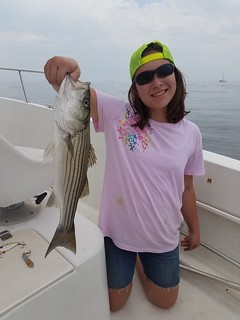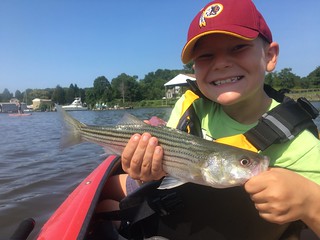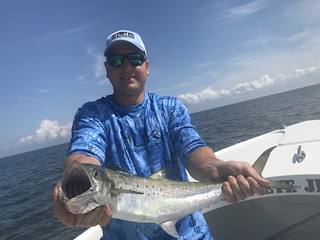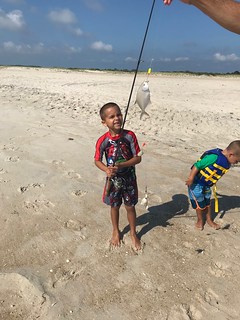Maryland Fishing Report: August 15
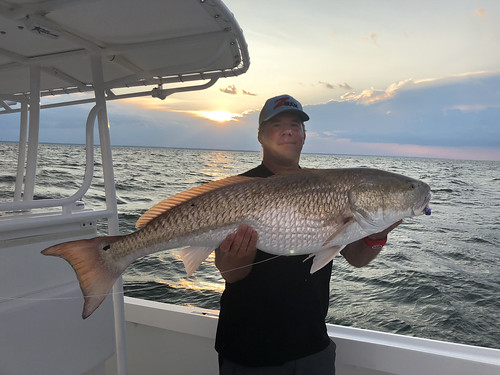
Travis Long was enjoying catch-and-release fishing for large red drum in the Chesapeake Bay recently and holds up a prize caught while jigging, before slipping this big girl back into the bay waters. Photo courtesy of Travis Long
One of the fun and exciting things about fishing is you just never know what surprises await when you cast your fishing line into the water. Some have been surprised with a record-breaking catch, a novelty catch or just a fun encounter with a fish to help round out a peaceful day. Enjoying the outdoors tends to be that way; you never can be sure what is around the next bend in a trail, or what a day out on the water has in store for you.
And for you photographers out there, the Maryland Natural Resource photo contest wraps up this month. Enter your best shots showcasing Maryland’s great fishing and outdoors by midnight Aug. 31.
Winners will be featured in the 2019 wall calendar; additional prizes include cash and park passes. Enter today!
Forecast Summary: Aug. 15-21
This week, high water temperatures in the bay will continue while water clarity is improving — though still reduced from high river flows entering the bay. Main bay surface water temperatures are averaging around 82 degrees to 84 degree during the day, and will continue to stay very warm through the next week. As of Aug. 8, the coolest waters from surface to bottom are from the Susquehanna Flats down to the Still Pond area. The temperature break continues to be near the Gunpowder Neck area, with cooler areas north and warmer waters south of that point. Remember, striped bass will avoid water above 84 degrees.
Since the record low hypoxia recorded in late July, oxygen conditions have returned to normal numbers for August. Department monitoring Aug. 8 shows adequate oxygen down to 20 feet at Swan Point and Bay Bridge, 13 feet at Kent Point, 30 feet at Gooses Reef and more than 36 feet at Cove Point and Smith Point. Anglers should continue to seek the best combination of clear, cool, oxygenated waters. This means fishing deeper or early in the morning in shallow waters when water temperatures can be about 3 degrees cooler. There will be above average tidal currents Wednesday and Thursday as a result of the new moon Aug. 12.
For the full weekly fishing conditions summary and more detailed and up-to-date fishing conditions in your area of the bay, be sure to check out Eyes on the Bay’s Click Before You Cast.
Fortunately, water quality conditions in the upper bay are steadily improving due to recent rains and windy conditions. Dissolved oxygen levels have improved, although water temperatures are still high. The flood gates at the Conowingo Dam are now closed but power generation releases are still far above average for this time of the year. The lower Susquehanna River and surrounding areas still report stained conditions.
The striped bass that were concentrated at the shoal areas off Tolchester have begun to move to the south. Striped bass are now being found along the channel edges at Swan, Love and Podickory points. Live lining spot has been a popular way to avoid the high number of small striped bass in the region and focus in on a larger grade of fish. Chumming is certainly effective but there are a large number of sub-legal fish attracted to the chum slicks. Channel catfish are being attracted to the chum slicks as well and will pick up baits that are resting on the bottom and meant for striped bass.
The bridge piers of the Francis Scott Key Bridge as well as the Bay Bridge are holding striped bass at about 20 feet. Live lining spot, eels or chunking has been a very popular way to target these suspended fish. For those who can get out on the water before sunup, there continues to be a topwater bite at the rock piles at the Bay Bridge and other shoreline structure areas.
Spot can be found on the west side of the Bay Bridge in about 12 feet to 15 feet of water and also at the mouth of the Magothy and Chester rivers. Pieces of bloodworms on a simple bottom rig will catch them and some manner of a live well is needed to keep them healthy on the way to the upper bay channel edges.
Surface water temperatures in the middle bay region are now holding around 84 degrees today and the salinity is 5 parts per thousand, which is about as low as this writer can remember. Improved dissolved oxygen levels in the middle bay region have improved and striped bass are being found widespread through the region, although unfortunately sparse in numbers. It may take some exploring with a depth finder or perhaps some trolling to locate them suspended along channel edges.
Chumming, chunking or live lining spot has been accounting for some catches at the outside edge of Hacketts Bar, Thomas Point, Bloody Point and various channel edges throughout the region. The throwback ratio when chumming continues to be high, but those live lining spot are able to catch larger striped bass.
There is a lot shallow-water action in the Eastern Bay area and the lower sections of the region’s tidal rivers. It is an early morning bite and to a lesser degree there is some action in the evenings. Casting topwater lures, jerkbaits, swimbaits and crankbaits are all good lures to use depending on water depth and grass conditions. Prominent points and shoreline structure such as rocks, piers and channel edges are all good places to target.
Good numbers of spot are available in the middle bay region at hard bottom locations. Eastern Bay, the Whitehall Bay edge of Hacketts Bar, the lower Choptank and other tidal rivers are good places to find spot. White perch are also being found in some of these same areas and in the region’s tidal rivers and creeks. Fishing with a bottom rig with grass shrimp or bloodworms near docks and piers over deeper water is a great way to catch some nice perch. Casting small spinnerbaits, spinners or jigs can also be another fun way to catch white perch along shoreline structure in the early morning or evening hours with light tackle.
There has been a good striped bass bite in the lower Potomac near St. Georges Island and similar steep channel edges in the area. Some are chumming and chunking but most are having great success with live spot. The rock piles north of Point Lookout and the Point No Point area have also been a great place to fish. Chumming will bring in a lot of smaller sub-legal striped bass and also bluefish — and of course the bluefish can make short work of a live spot.
There are a lot of spot in the region, and some of the best places to catch them are the lower Potomac near Coltons Point and the St. Mary’s River. The lower Patuxent has a lot of spot as does the Hoopers Island area south to the Pocomoke Sound region. Croaker are becoming more common at many of these same areas, as are white perch. Pieces of bloodworms are the bait of choice for catching spot, while croaker and white perch can be caught on peeler crab or bloodworms.
Trolling is a viable way to catch striped bass as well as bluefish this week. Red and green hoses or spoons behind inline weights are popular. Gold spoons and those with a splash of chartreuse on them have been working well in the stained waters. Over by the Target Ship, trolling large spoons or jigging can be the ticket for some catch-and-release action with large red drum. Very few Spanish mackerel are being seen in the lower bay region, which may be due to diluted salinity.
Recreational crabbing continues to pick up speed as successive molts bring more legal sized crabs into the fishery. The top crabbing locations tend to be in the middle and lower bay regions this week. The lower Eastern Shore creeks tend to offer some of the most productive crabbing. Many are reporting crabs holding in 10 feet to 12 feet of water, and fresh chicken necks or razor clams are the top baits.
Deep Creek Lake is offering several fishing opportunities this week. For those who can be out on the lake before sunup, there is shallow-water action for largemouth bass along the shorelines of coves where grass dominates. Casting topwater lures can be an exciting way to fish. Later on in the morning, targeting thick surface grass with stick worms can entice loafing bass underneath to pick up a bait. Largemouth bass will also be seeking shade under floating docks and fallen tree tops. A variety of soft plastics, stick worms, grubs and small crankbaits work well in these areas.
Drifting along deep weed lines with minnows fished deep will often catch a mix of yellow perch, smallmouth bass and walleye. Walleye and trout can also be found deep along the dam face by slow trolling with minnows or nightcrawlers.
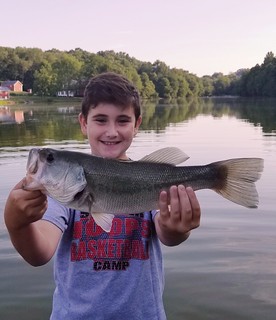
Josh Pepin celebrated his birthday by catching this nice largemouth bass while fishing with his dad at Lake Linganore. Photo by Mike Pepin
The upper Potomac River continues to exhibit high flows this week, so fishing and boating are not recommended. The streams and small rivers of Western Maryland are providing wonderful trout fishing due to good stream flows. This presents a wonderful opportunity for fly fishing with a variety of dry flies, streamers and nymphs. The upper Gunpowder River in the central region is also providing good trout fishing due to water releases from Prettyboy Reservoir.
Largemouth bass fishing continues in a typical summer mode of fishing shallow areas at dawn and evenings and deeper shady and cool areas during the day. This pattern holds true whether you are fishing a farm pond or a large tidal river. Topwater baits are hard to beat when fishing shallow grass along shorelines and soft plastics and stick worms when fishing under thick surface grass that provides cool shade over deeper waters.
The tidal Potomac continues to provide good fishing and with stained waters in the river, many are finding improved fishing opportunities in feeder creeks where the waters are clearer. The tidal rivers of the Eastern Shore are in good shape in regards to water clarity. The upper Sassafras, Chester and Choptank rivers are offering relatively clear water conditions and are peaceful and productive areas to fish for largemouth bass. Farther down the Eastern Shore, the Nanticoke and Wicomico river systems are fun places to explore and enjoy good fishing for largemouth bass.
The tidal Potomac area has always been thought of as an epicenter area for northern snakeheads, but the lower Eastern Shore is quickly catching up as populations expand. Smaller rivers like the Blackwater and Chicawicomico are full of northern snakeheads and these are picturesque places to fish in a small boat or kayak. Many of the locals fish with live minnows, but surface lures like buzzbaits always seem to get the attention of northern snakeheads. Recently there was an 18.7-pound northern snakehead caught in the Blackwater area, which shows the potential for record-breaking northern snakeheads in the region.
Surf fishing has picked up a click or two with a strong kingfish and croaker bite occurring along the Ocean City and Assateague beaches. A mix of flounder, bluefish, spot and occasional small black drum are also being caught, and one young boy even recently caught a pompano in the surf. Sand fleas are a very popular bait along with clams, squid and cut mullet.
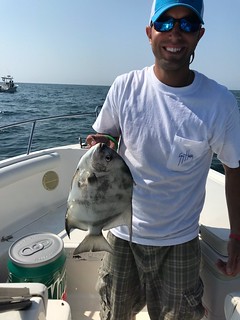
Bryan Floyd did some wreck fishing with his dad and holds up one of the spadefish they caught. Photo by Herb Floyd
At the inlet, sheepshead are being caught at the jetties, along with a few triggerfish and flounder. Flounder fishing has been very good in the back bay channel areas leading toward the inlet and Sinepuxent Bay near the airport. Traditional minnow and squid strip baits work well and white Gulp mullet baits or live spot and peanut menhaden are catching some of the larger flounder.
Outside the inlet there are some bluefish, Spanish mackerel and cobia on the nearshore shoals. Farther out at some of the lumps inside the 30 Fathom line a mix of king mackerel, Spanish mackerel, bonito, small dolphin and occasionally a bluefin tuna are being caught by trolling.
The wreck and reef sites are holding some impressive flounder this week along with some sea bass, triggerfish and spadefish. The sites farther offshore are holding a larger grade of sea bass, tautog and blueline tilefish.
The canyons continue to hold a healthy mix of offshore species and the crowds have dispersed now that the White Marlin Open is history. One can expect to encounter a mix of blue and white marlin, yellowfin tuna, Bluefin tuna, bigeye tuna, dolphin and wahoo depending on location and luck.
“… when the lawyer is swallowed up with business and the statesman is preventing or contriving plots, then we sit on cowslip-banks, hear birds sing and possess ourselves in as much quietness as these silent silver streams.” – Izaak Walton, 1653
 ABOUT THE AUTHOR Keith Lockwood has been writing the Fishing Report since 2003 and has had a long career as a fisheries research biologist since 1973. Over the course of his career he has studied estuarine fishery populations, ocean species, and over a decade long study of bioaccumulation of chemicals in aquatic species in New Jersey. Upon moving to Oxford on the eastern shore of Maryland; research endeavors focused on a variety of catch-and-release studies as well as other fisheries related research at the Cooperative Oxford Laboratory. Education and outreach to the fishing public has always been an important component to the mission of these studies. Keith is an avid outdoorsman enjoying hunting, fishing, bird dogs, family and life on the eastern shore of Maryland.
ABOUT THE AUTHOR Keith Lockwood has been writing the Fishing Report since 2003 and has had a long career as a fisheries research biologist since 1973. Over the course of his career he has studied estuarine fishery populations, ocean species, and over a decade long study of bioaccumulation of chemicals in aquatic species in New Jersey. Upon moving to Oxford on the eastern shore of Maryland; research endeavors focused on a variety of catch-and-release studies as well as other fisheries related research at the Cooperative Oxford Laboratory. Education and outreach to the fishing public has always been an important component to the mission of these studies. Keith is an avid outdoorsman enjoying hunting, fishing, bird dogs, family and life on the eastern shore of Maryland.

